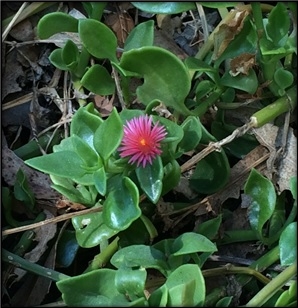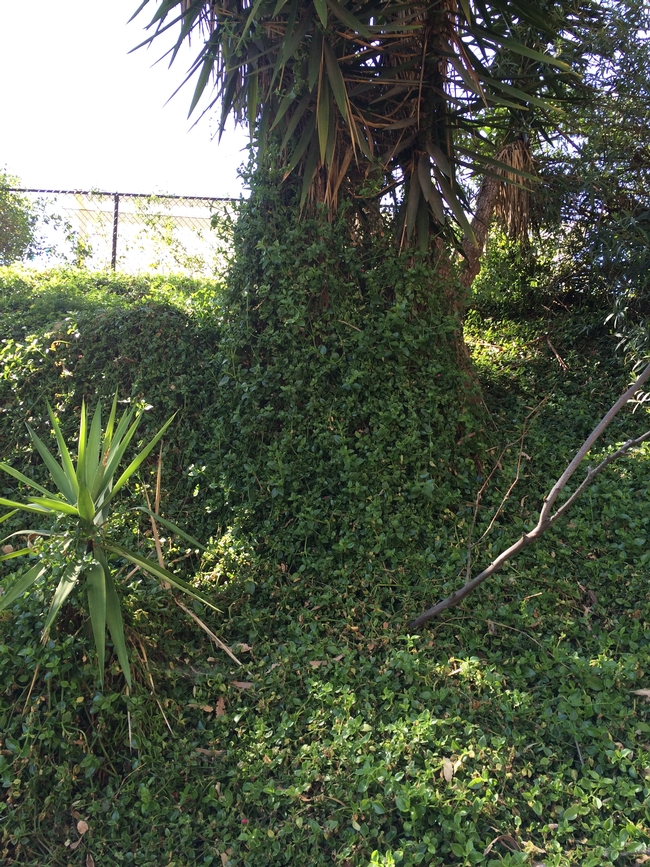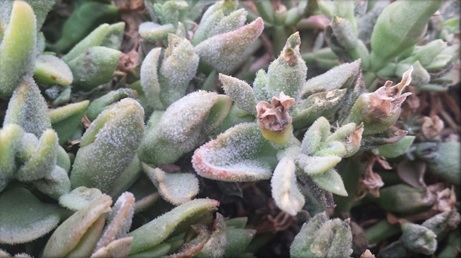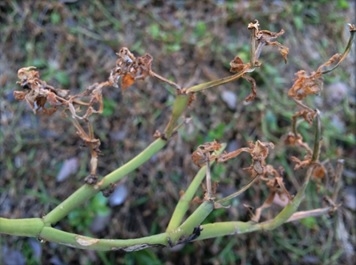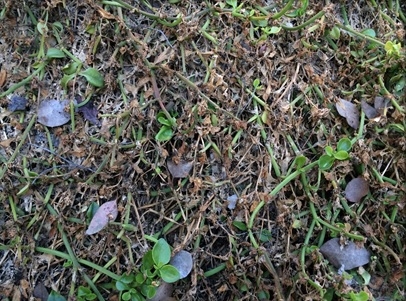Healthy red apple ice plant, Aptenia cordifolia. Photo by Heather Scheck, Santa Barbara Ag Commissioner's Office
A downy mildew caused by the oomycetous fungus, Peronospora mesembryanthemi Verwoerd has recently been confirmed by the USDA -APHIS from a red apple ice plant sample collected in San Diego. Since its first finding in San Diego County last summer, the disease has spread to Orange, San Bernardino, and Ventura counties and is now found in the Goleta area in Santa Barbara County. Peronospora mesembryanthemi was first reported from South Africa (Verwoerd, 1924) and later in the United Kingdom (Francis and Waterhouse, 1988) and New Zealand (McKenzie and Dingley, 1996), but has never been reported in North America. The host range of P. mesembryanthemi is thought to be limited to ice plants and it is currently found infecting the red apple ice plant, Aptenia cordifolia, the trailing ice plant or the pink carpet, Delosperma (syn. Mesembryanthemum) cooperi, and Lampranthus sp. in California. Both these ice plant species are native to southern Africa. Because of their environmental hardiness, ease of growing, and bright, colorful flowers, ice plants are grown as ornamental plants or found as groundcovers. However, the red apple ice plant is listed as an invasive plant by the California Exotic Pest Plant Council. It can sometimes grow like a weed.
Red apple ice plant overwhelming yucca plants. Photo by Heather Scheck, Santa Barbara Ag Commissioner's Office
Pathogen: Downy mildew appears as a mat of grey, blue, or brown fungal growth on the lower or both sides of leaves and other infected plant parts. Fungal growth consists of the asexual fruiting structures known as sporangia that are produced on sporangiophores, which are specialized hyphae. Downy mildew fungi cause systemic infection and grow internally in all plant parts. Infection rapidly spreads under cool and wet conditions. Windblown rain or sprinkler splashing spreads disperse sporangia and aid in the disease spread. Downy mildew fungi are obligate parasites of plants and most of them have narrow host range of one or just a few hosts.
Greyish sporulation of Peronospora mesembryanthemi on an ice plant. Photo by Jose Rodriguez, Soil and Plant Laboratory, Inc.
Downy mildew-infected red apple ice plant. Photo by Heather Scheck, Santa Barbara Ag Commissioner's Office
Severe downy mildew damage to an ice plant. Photo by Heather Scheck, Santa Barbara Ag Commissioner's Office
Damage: The rapid spread of P. mesembryanthemi through southern California could be from accidental movement of infected nursery stock. Severe damage with heavy or total loss of plantings is becoming common in southern California counties where the disease is currently found.
Management: There are relatively few fungicides effective against oomycetous fungi and control can be very difficult. Since most of the fungicides are fungistatic (inhibit the fungal growth) rather than fungicidal (kill the fungus) against P. mesembryanthemi, fungicidal treatments only suppress the fungus, but systemic infections cannot be cured. Downy mildew fungi evolve very quickly to form new races and can rapidly develop fungicide resistance. (Is this sentence necessary? It is scary.)
Good cultural practices and sanitation can prevent or minimize downy mildew of ice plants. Some management options include:
- Prune plants regularly and remove weeds to improve air circulation and reduce fungal growth.
- Avoid overhead irrigation during cool weather.
- Consider watering in the morning hours so that plants dry during the day.
- Do not over- or under-fertilize as it may increase the chances of infection.
- Monitor highly susceptible species like the red apple ice plant and remove and destroy plants with symptoms of infection.
- Consider other host plants as groundcovers when replacing diseased ice plants.
http://ucanr.edu/articlefeedback
References:
Chitambar, J. 2016. Peronospora mesembryanthemi. (http://blogs.cdfa.ca.gov/Section3162/?tag=peronospora-mesembryanthemi)
Francis, S. and G. Waterhouse. 1988. List of Peronosporaceae reported from the British Isles. Trans. Brit. Mycol. Soc. 91: 1-62.
McKenzie, E.H.C. and J. M. Dingley. 1996. New plant disease records in New Zealand: miscellaneous fungal pathogens III. New Zealand J. Bot. 34: 263-272.
Verwoerd, L. 1924. Peronospora mesembryanthemi n. sp., die oorsaak van ‘n donsige skimmelsiekte van Mesembryanthemum-soorte. Ann. Univ. Stellenbosch 2A: 13-23.
